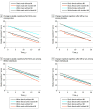Association Between Acute Myocardial Infarction and Cognition
- PMID: 37252710
- PMCID: PMC10230369
- DOI: 10.1001/jamaneurol.2023.1331
Association Between Acute Myocardial Infarction and Cognition
Abstract
Importance: The magnitude of cognitive change after incident myocardial infarction (MI) is unclear.
Objective: To assess whether incident MI is associated with changes in cognitive function after adjusting for pre-MI cognitive trajectories.
Design, setting, and participants: This cohort study included adults without MI, dementia, or stroke and with complete covariates from the following US population-based cohort studies conducted from 1971 to 2019: Atherosclerosis Risk in Communities Study, Coronary Artery Risk Development in Young Adults Study, Cardiovascular Health Study, Framingham Offspring Study, Multi-Ethnic Study of Atherosclerosis, and Northern Manhattan Study. Data were analyzed from July 2021 to January 2022.
Exposures: Incident MI.
Main outcomes and measures: The main outcome was change in global cognition. Secondary outcomes were changes in memory and executive function. Outcomes were standardized as mean (SD) T scores of 50 (10); a 1-point difference represented a 0.1-SD difference in cognition. Linear mixed-effects models estimated changes in cognition at the time of MI (change in the intercept) and the rate of cognitive change over the years after MI (change in the slope), controlling for pre-MI cognitive trajectories and participant factors, with interaction terms for race and sex.
Results: The study included 30 465 adults (mean [SD] age, 64 [10] years; 56% female), of whom 1033 had 1 or more MI event, and 29 432 did not have an MI event. Median follow-up was 6.4 years (IQR, 4.9-19.7 years). Overall, incident MI was not associated with an acute decrease in global cognition (-0.18 points; 95% CI, -0.52 to 0.17 points), executive function (-0.17 points; 95% CI, -0.53 to 0.18 points), or memory (0.62 points; 95% CI, -0.07 to 1.31 points). However, individuals with incident MI vs those without MI demonstrated faster declines in global cognition (-0.15 points per year; 95% CI, -0.21 to -0.10 points per year), memory (-0.13 points per year; 95% CI, -0.22 to -0.04 points per year), and executive function (-0.14 points per year; 95% CI, -0.20 to -0.08 points per year) over the years after MI compared with pre-MI slopes. The interaction analysis suggested that race and sex modified the degree of change in the decline in global cognition after MI (race × post-MI slope interaction term, P = .02; sex × post-MI slope interaction term, P = .04), with a smaller change in the decline over the years after MI in Black individuals than in White individuals (difference in slope change, 0.22 points per year; 95% CI, 0.04-0.40 points per year) and in females than in males (difference in slope change, 0.12 points per year; 95% CI, 0.01-0.23 points per year).
Conclusions: This cohort study using pooled data from 6 cohort studies found that incident MI was not associated with a decrease in global cognition, memory, or executive function at the time of the event compared with no MI but was associated with faster declines in global cognition, memory, and executive function over time. These findings suggest that prevention of MI may be important for long-term brain health.
Conflict of interest statement
Figures


Comment in
-
Myocardial Infarction Bends the Curve of Age-Related Cognitive Decline, but How?JAMA Neurol. 2023 Jul 1;80(7):665-667. doi: 10.1001/jamaneurol.2023.0466. JAMA Neurol. 2023. PMID: 37252720 No abstract available.
References
Publication types
MeSH terms
Grants and funding
- R01 AG023629/AG/NIA NIH HHS/United States
- HHSN268201800005I/HL/NHLBI NIH HHS/United States
- U01 HL096902/HL/NHLBI NIH HHS/United States
- HHSN268201700002I/HL/NHLBI NIH HHS/United States
- HHSN268201700003I/HL/NHLBI NIH HHS/United States
- HHSN268201500003I/HL/NHLBI NIH HHS/United States
- R01 AG054069/AG/NIA NIH HHS/United States
- R35 AG071916/AG/NIA NIH HHS/United States
- UL1 TR000040/TR/NCATS NIH HHS/United States
- HHSN268201800004I/HL/NHLBI NIH HHS/United States
- U01 HL096917/HL/NHLBI NIH HHS/United States
- HHSN268201800003I/HL/NHLBI NIH HHS/United States
- R01 AG051827/AG/NIA NIH HHS/United States
- P30 AG053760/AG/NIA NIH HHS/United States
- 75N92020D00007/HL/NHLBI NIH HHS/United States
- K23 AG080035/AG/NIA NIH HHS/United States
- HHSN268201800006I/HL/NHLBI NIH HHS/United States
- K01 AG050699/AG/NIA NIH HHS/United States
- HHSN268201800001C/HL/NHLBI NIH HHS/United States
- U01 HL080295/HL/NHLBI NIH HHS/United States
- 75N92020D00001/HL/NHLBI NIH HHS/United States
- R01 AG020098/AG/NIA NIH HHS/United States
- HHSN268201200036C/HL/NHLBI NIH HHS/United States
- RF1 AG068410/AG/NIA NIH HHS/United States
- R01 AG040282/AG/NIA NIH HHS/United States
- 75N92020D00005/HL/NHLBI NIH HHS/United States
- HHSN268201700001I/HL/NHLBI NIH HHS/United States
- R01 NS029993/NS/NINDS NIH HHS/United States
- 75N92021D00006/HL/NHLBI NIH HHS/United States
- P30 AG024824/AG/NIA NIH HHS/United States
- HHSN268201700004I/HL/NHLBI NIH HHS/United States
- K23 NS112459/NS/NINDS NIH HHS/United States
- R01 NS102715/NS/NINDS NIH HHS/United States
- 75N92020D00004/HL/NHLBI NIH HHS/United States
- UL1 TR001420/TR/NCATS NIH HHS/United States
- HHSN268201500001I/HL/NHLBI NIH HHS/United States
- HHSN268201800007I/HL/NHLBI NIH HHS/United States
- R01 HL127659/HL/NHLBI NIH HHS/United States
- 75N92020D00002/HL/NHLBI NIH HHS/United States
- R01 AG058969/AG/NIA NIH HHS/United States
- HHSN268201700005I/HL/NHLBI NIH HHS/United States
- U01 HL096899/HL/NHLBI NIH HHS/United States
- 75N92020D00003/HL/NHLBI NIH HHS/United States
- 75N92020D00006/HL/NHLBI NIH HHS/United States
- UL1 TR001079/TR/NCATS NIH HHS/United States
- U01 HL130114/HL/NHLBI NIH HHS/United States
- R01 AG063887/AG/NIA NIH HHS/United States
- P30 AG072947/AG/NIA NIH HHS/United States
- U01 HL096814/HL/NHLBI NIH HHS/United States
- HHSN268200800007C/HL/NHLBI NIH HHS/United States
LinkOut - more resources
Full Text Sources
Medical

